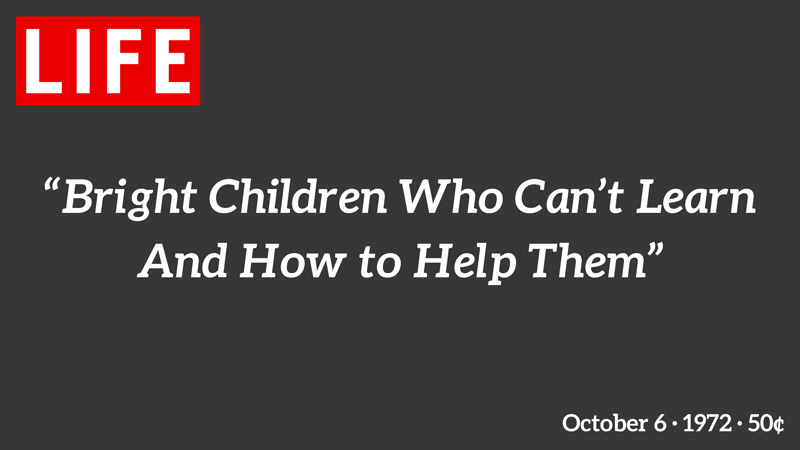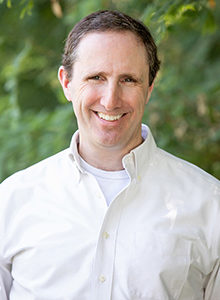In April 2023, it was my distinct privilege to be invited to The Center School in Somerset, NJ, the special needs school where it all began for me as a Kindergartener back in the mid ’70s, to give an author talk about my book A Long Walk Down a Winding Road. I felt as though I had triumphantly come full circle, having attended the school as a vulnerable, unidentified autistic and learning-disabled youngster, and returning as a proud, self-confident, openly autistic author, advocate, public speaker, husband, father, and successful information technology consultant. Who I would become speaks to the strong educational foundation The Center School helped instill in me during those critical early years, and I will forever be indebted.

The school had recently celebrated its 50th anniversary, and as a token of the staff’s gratitude for me having traveled far to share my book, I was given an authentic copy of the October 6, 1972 issue of Life Magazine which featured an article on The Center School and its students when the school was a little more than a year old. Very heartened by this gesture, I could hardly wait to take the trip back in time I knew was in store for me: ads for TV’s and cars which today I can imagine seeing in a museum, articles about how the North Vietnamese people had learned to live with ongoing bombing, Richard Nixon’s lead in the presidential election polls and the piece I was most eager to check out, what Life Magazine had to say about my early elementary school back in the day.
What I read I did not see coming, and the emotional impact was not subtle by any means. It didn’t matter that the article was more than 50 years old. What did matter was what it said about me and my fellow Center School classmates.
Entitled “An Agony of Learning,” the article described The Center School’s learning-disabled students, which would include me two years after publication, in particularly harsh terms. We were referred to as youngsters who could not learn properly and victims to be pinpointed. Something had gone wrong with our damaged nervous systems. We possessed “brutally handicapping learning flaws.” One of us had been thought of as retarded prior to arriving at The Center School. Another boy’s picture was shown of him crying tears which “masked a futile effort to understand.”
To say that “An Agony of Learning” helped perpetuate harmful stereotypes about learning-disabled individuals is an understatement granted these descriptions. Neurodivergent individuals like me (those of us with neurotypes that are in the minority – autism, ADHD and learning disabilities, for example) contend with these kinds of stereotypes to this day. Though more than 50 years old, the article remains relevant in this respect.
Not one of the aforementioned depictions is consistent with my own memories and lived experiences as a learning-disabled grade school student. Learning was sometimes challenging for me, other times not, depending upon the academic subject I was studying, but never agonizing in the true sense of the word. Nothing has ever been wrong with my nervous system; I was simply born with a divergent neurotype which brings unique challenges as well as strengths and talents. The notion that I was a victim as a child is laughable. Not all forms of hardship render an individual a victim, particularly if one learns how to compensate for them, as I did.
Worst of all, the article’s front cover reference does the most damage because of where it appears, in plain sight, circulated worldwide and looked at by who knows how many millions of people: “Bright children who can’t learn – and how to help them.” Not at all true of learning-disabled students, yet this was the messaging Life Magazine presented to its then extensive readership about us.
Words matter, particularly those that appear in the spotlight. They are often taken literally when a periodical as prominent as Life Magazine was in 1972 prints them, regardless of whether or not they are valid. Many will jump to conclusions and generalize when the stage is set for them to do so. The damage is done.
Had I been allowed to choose the front cover wording for the October 6, 1972 issue of Life Magazine, I would have gone with something more civil like “a new, innovative school is helping learning-disabled children,” “learning-disabled children exceeding expectations at a new, innovative school” or the like. “Bright children who can’t learn” is anything but civil. It taps into the “they are broken and need to be fixed” deficit-centric narrative around learning disabilities and autism which was prevalent in the 1970’s and which persists to this day.
Civility tends not to sell as well as negativity does, and that is what front cover language is expected to do for a magazine, but at what cost? The stigmatization of disability ended up winning out for all the wrong reasons.
Having been diagnosed as learning-disabled in 1972, Life Magazine essentially rendered me “a bright child who can’t learn,” though I was able to prove the front cover propaganda wrong. It wasn’t as if I couldn’t learn. It was that I learned differently. When the proper supports are in place and special education teachers know what they’re doing, their learning-disabled students learn plenty. I am but one case in point.
At The Center School, we learned how to work around difficulties by leveraging our abilities and we did so in a structured, accommodating learning environment. What I would accomplish after my departure stemmed from my success there. I performed well enough during my middle elementary school years to no longer require special education classes come 5th Grade. Throughout my middle and high school years, I consistently made the honor roll, after which I was accepted to my 1st choice college.
Nonetheless, “An Agony of Learning” and its hurtful portrayal of learning-disabled children did not do us any favors. How we were depicted had to have influenced public opinion at least to some extent, and public opinion affects us on many fronts, among these, our sense of self. Autistic individuals, including those of us identified early on as learning-disabled and later in life as autistic, tend to be very sensitive to how others describe us, and we tend to take things at face value. I am most grateful that I have been able to develop strong enough self-esteem such that adverse external influences are for the most part kept at bay, though not all neurodivergent individuals are as fortunate.
It goes to show that the mass media should never be allowed to define how we view ourselves. This is for each of us, and nobody else, to decide. Toxic stereotypes and misinformation are regrettable realities which, with enough effort, can be risen above.
As for The Center School, so much can be said for this wondrous institution. Countless vulnerable young people who have attended this school have thrived against all kinds of odds. Defying what Life Magazine had to say about us all those years ago, our accomplishments speak for themselves.
Sam Farmer is a neurodiversity community self-advocate, writer/author, and public speaker. Diagnosed later in life as autistic, Sam shares stories of lived experiences, ideas, and insights as to how one can achieve greater happiness and success in the face of challenge and adversity. A Long Walk Down a Winding Road – Small Steps, Challenges, & Triumphs Through an Autistic Lens is his first book. Visit samfarmerauthor.com to learn more.






